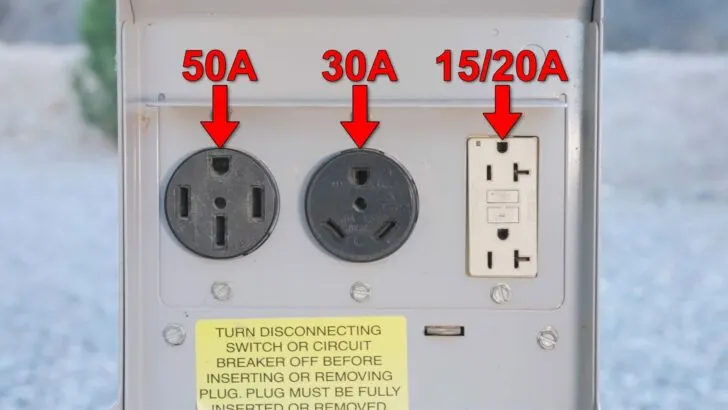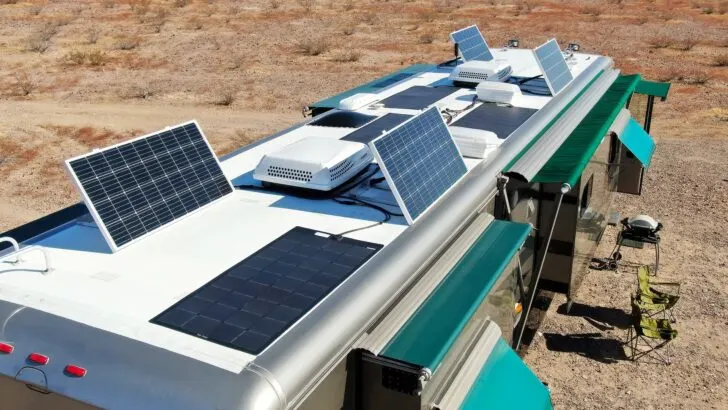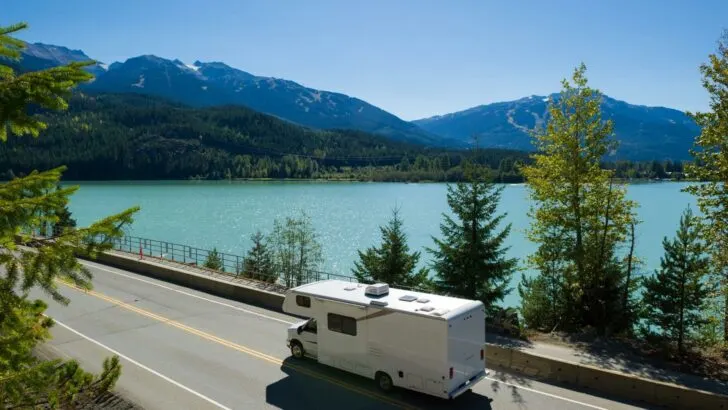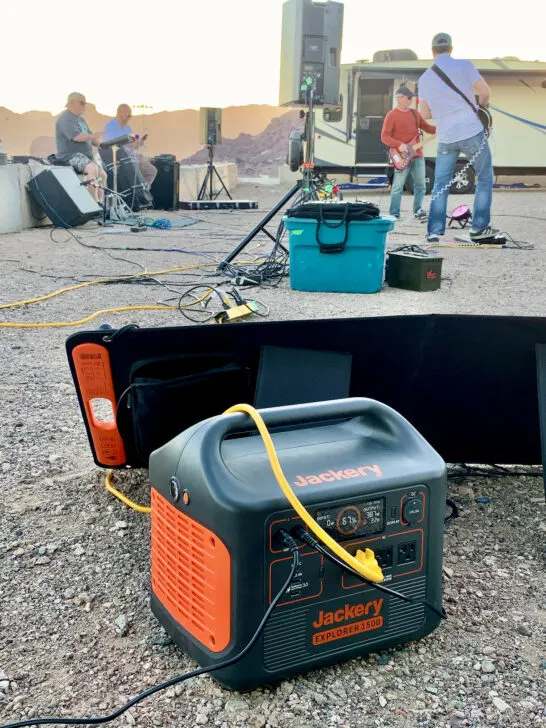No matter how you slice it, keeping your RV batteries topped up is an important focus when camping. If you love boondocking as much as we do, or even if you stop for a quick overnight at a Wal-Mart or a rest area, you need battery power to run lights, the water pump, vent fans, the fridge, and much more. Luckily, there are multiple ways of charging an RV battery and we’re covering them all in this post.
Options for Charging an RV Battery
Most powered RV gear runs off one of two types of electricity: 12-volt direct current (12V DC) supplied by your rig’s house batteries, or 120-volt alternating current (120V AC) supplied when you’re connected to shore power or running your generator.
There are two particularly great things about RV house batteries. First, they provide 12V DC power whether you’re hooked up to shore power or not, so they’re great for boondocking off the grid. Your RV’s house battery bank directly powers anything that runs off 12V DC, including the water pump, vent fans, and most lighting.
Second, house batteries can also provide 120V AC power through a device called an inverter. This allows you to enjoy just about anything on your rig that uses electricity, no matter where you are.
There are many ways to charge an RV battery or battery bank, and depending on the size of your bank and how much power you consume, you may even need to use a combination of methods to keep your house batteries topped up.
Whether your RV has lead-acid (flooded, AGM, or gel) or lithium batteries, a charged battery is the only type that’ll power your “house” when your rig isn’t hooked up to shore power (or your generator isn’t running).
Let’s look at the six most common ways to fully charge your RV batteries so they can power everything in your rig.
Shore Power
When your RV is connected to a power pedestal at a campground, the 120V does more than power AC appliances such as air conditioning, a TV, or a microwave oven. It also supplies 120V AC power to your rig’s onboard charger, converter/charger, or inverter/charger so it can charge the batteries.
Typically, an RV will have either a 30-amp or 50-amp plug that connects to a corresponding outlet, (though the smallest RVs are sometimes equipped with a 15-amp plug, just like those on the wall in your home).

This is a typical campground pedestal, with 50-amp, 30-amp, and 15/20-amp outlets.
Anytime your RV is plugged in using its power cord, the 12V house batteries get charged, usually with the help of a built-in converter (also known as a converter/charger). Larger RVs are often equipped with inverters that produce 120V AC from the 12V DC battery bank. They usually combine all of these features into one unit called an inverter/charger.
For more detail about that, see our post “Do RV batteries charge when plugged into shore power?”
Generator
Whether a generator is built-in or portable, it supplies 120V AC power, similar to a shore power pedestal. This means your generator provides 120V power to your electrical appliances, including your onboard converter/charger which also replenishes the power in your house batteries.
But, similar to a 15-amp power outlet, you’re limited by the generator’s output capacity, so you can’t run everything all at once. The larger a generator’s output, the more it can handle at one time.
The 7.5 kW Onan QuietDiesel in our Newmar could power both roof air conditioners and charge the batteries all at once. But there are limits. For example, we wouldn’t likely microwave dinner while all of the above are happening. If the RV had a 10kW or 12kW genset, sure thing. Why not?!
Solar Power
Solar power is another way to charge an RV battery bank, and actually our favorite way.
Charging your RV’s house batteries with solar power requires either solar panels permanently installed on the roof with their own solar charge controller or portable panels. Those are placed in the sun when you reach your destination and typically have a built-in charger.
Most RVs don’t come off the lot with pre-installed solar panels, although more and more are advertised as “solar-ready RVs” due to some pre-wiring they’ve run. The popularity of boondocking has made solar panels into desirable add-ons for many RVers.
It’s important to note that the number of solar panels you need to charge your RV batteries should be appropriate for the size of your battery bank and how much power you consume off-grid. You’ll need plenty of sun as well, so location, climate, and time of year come into play. Winter means short days with the sun low on the horizon.
Rig size and equipment are also important. If you have a big diesel pusher and want to power your entire rig with solar, you’ll need a large bank of solar panels like the one we installed on our Newmar Mountain Aire.
With that system, we could function almost as if we were plugged into shore power (including our residential refrigerator) without having to run our generator.

The solar array on the roof of our Mountain Aire used both rigid and flexible panels. The rigid panels are mounted on SolaRVector tilt kits, which is super helpful during the winter when the sun stays low in the sky.
You may want to check out our post “How much solar do I need for my RV?” You can also see our 1,300-watt RV solar system in our video:
Alternator
An alternator is another great way of charging an RV’s house batteries. If wired properly, a motorhome’s alternator will charge your house batteries as you drive. If you have a towable RV, your towing vehicle’s engine battery can also charge your RV’s house batteries under certain conditions. Let’s take a look at both.
Motorhome’s Alternator
Many/most motorized RVs are wired so that the engine’s alternator charges both the vehicle (chassis) and the RV (house) batteries as you drive. If your RV is wired this way, simply driving down the highway is a great way to recharge your house battery bank.

One of the easiest ways to charge your RV’s house batteries is to drive your rig to your camping destination.
Most RVs use either a Bi-directional Relay Delay (BiRD) system or an echo charger. The BiRD system uses a relay to link the chassis and house batteries, while an echo charger uses a portion of the charging current from the chassis battery and supplies it to the house battery bank. Note that an echo charger can be installed on an RV that didn’t come with one using a unit like this one from Xantrex:
- Included Components: Xantrex Technology Inc, 82-0123-01 Digital Echo-Charge 15A
Tow Vehicle’s Alternator
If your RV is towable, it’s also possible for your rig’s house battery bank to be recharged by your towing vehicle’s alternator. However, this may require some upgraded wiring or a dedicated DC-to-DC charger to ensure that several important functions occur:
Proper Charge Cycle Is Used
The proper charge cycle for the RV’s house battery bank must be used, especially if they’re Lithium. Those require a different charging profile than flooded lead-acid batteries do, which requires the system to be set up correctly for the different battery types.
Overcharging Doesn’t Occur
You want to ensure that the RV’s batteries aren’t overcharged no matter what type of house batteries you have. Even flooded lead-acid batteries can be damaged by overcharging.
Alternator Isn’t Over-Taxed
It’s important that your tow vehicle’s alternator isn’t overtaxed by constantly running at too high a load. Charging an RV’s house batteries off the towing vehicle’s alternator may require upgrading to a more powerful alternator to prevent drawing more power than it’s rated to put out.
Correct Configuration Is Used
While a towable RV is connected to the towing vehicle, differences in battery resting voltages can drain the RV’s batteries instead of charging them. To prevent this, it’s important to ensure that the system is installed and set up correctly.
External Battery Charger
An external battery charger can be used to charge an RV battery. This is generally done either when batteries are stored during the off-season or because the RV doesn’t have a 3-stage built-in charger. It’s cheaper and easier to buy an upgraded portable charger than it is to upgrade the built-in charger that came with the RV.
For more information, see our post on RV battery chargers. You may also want to check out our post on RV converters vs battery chargers to better understand the difference between the two.
Portable Power Bank
Some travelers use a portable power bank to charge devices and small appliances off the grid, but it can also be used in an emergency, even with RVs that have a built-in power system.

A portable power bank like our Jackery can not only charge devices and power small appliances but can also be used in an emergency to recharge your RV house battery. Here, it’s powering a Wicked Truth rehearsal at the annual Xscapers Bash!
Using a portable power bank can offload some power needs away from your onboard battery bank, making it easier to keep it charged. It can also be used to recharge your house batteries. Also known as a “solar generator” when paired with portable solar panels, these devices can be a lifesaver. You can see a couple of our four Jackery solar panels visible in the photo above.
We’ve used our Jackery portable power bank to top up our onboard battery during overcast weather when our rooftop panels weren’t able to keep up. Even on a big diesel pusher with a large house battery bank, it helped a lot during times of limited sunshine.
To do this, we dog-boned our RV’s power cord down to a 15-amp plug and connected it to a 120V AC outlet on the Jackery, allowing it to supply power to our onboard inverter/charger.
- LONG LASTING ENDURANCE: The Explorer 500 portable power station is built with the lithium-ion battery pack, in a safely designed frame structure to...
- SUPPORT PASS-THROUGH CHARGING: This power station features 1* AC outlet (110V 500W 1000W Peak), 3*USB-A ports, 2* DC ports, and 1*car port. Its...
It’s important to note that a portable power bank doesn’t last very long when doing this and isn’t the most efficient way to use its power. But it does work so you can certainly use it as a backup. You can then use portable solar panels to charge it back up the next day, and rinse and repeat as often as needed.
NOTE: If you have a surge protector or EMS system monitoring your RV’s incoming power, you may not be able to use this trick to recharge your house battery bank. Surge protectors (like our awesome Hughes Power Watchdog) may detect that the solar generator/power bank has a missing or floating neutral and/or bad ground. This is normal since the power bank isn’t wired the same way as an RV park’s electrical system.
You may be able to solve the problem with a neutral grounding plug which you would plug into one of the 120V AC outlets on your solar generator/power bank.
- Provide the correct working path for the generator quickly and efficiently, and solve the grounding problem of the generator.
- The plug is made of high-quality materials, with good conductivity, not easily broken or deformed, durable, and safe to use.
If a neutral grounding plug doesn’t work for you, you may simply need to unplug your surge protection while topping up your house battery from a portable power bank. The risk from doing that is minimal and unlikely to cause any problems.
You can read more in our post on solar generators for RVs and you can also check out our post on the CarGenerator, another source of portable power on the go.
With multiple ways of charging an RV battery bank, you should be able to keep them topped up to deliver DC power to your rig.
Free RVing Tips, Tricks, Reviews & Giveaways
As 20-year full-timers, we share everything we’ve learned about RVing over the years. Join our online community to receive a wealth of great RVing knowledge delivered daily to your inbox.
Whether you’re a new RVer or a seasoned full-timer, you’ll love the wide range of RVing topics we cover. Don’t miss a single article or any of our famous Giveaways. Subscribe to our newsletter today!





Roland
Monday 15th of April 2024
Great overview of charging options. Regarding the use of a portable power station, I would recommend either using its DC output direct to the batteries or turning off your rig's charger and just using the power station's AC to run AC loads as you described. The inverter in the power station and the DC converter both use energy in their conversions, so doing away with one loss can save 10-20% of your available battery power.